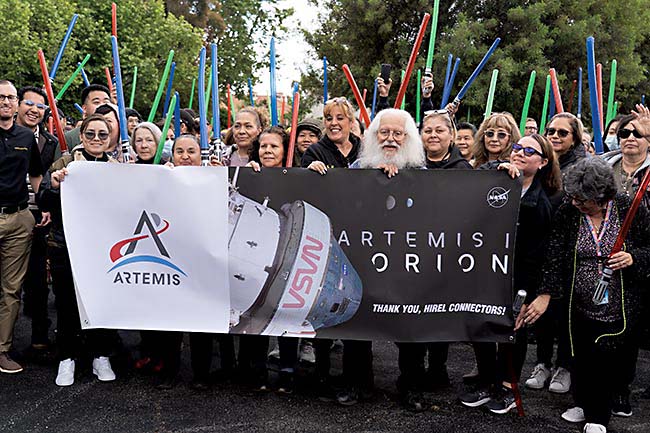Claremont company supplies crucial tech for NASA

by Andrew Alonzo | aalonzo@claremont-courier.com
Officials from the National Aeronautics and Space Administration and Lockheed Martin Corporation recently met with engineers and directors from one of their key suppliers: Claremont’s HiRel Connectors Inc.
HiRel products aid NASA’s Orion spacecraft, one of two transportation vessels used for its Artemis missions.
The NASA and Lockheed execs were in town visiting Southern California companies to thank them for their contributions to its Artemis I spacecraft.
HiRel is an eight-warehouse operation with 480 employees. It was founded by local engineer Fred Baumann in 1967. Lockheed Martin entered talks with HiRel in 2011 to manufacture connectors that could successfully separate NASA’s Orion craft from the Space Launch System during the Artemis missions. Design and manufacturing followed years later.

HiRel’s D38999 Series III winged, self-locking titanium plugs will help NASA’s Orion spacecraft separate from the Space Launch System rocket over the next few years.

Chris Chastain of Lockheed Martin, left, shakes hands with HiRel founder Fred Baumann, who holds a plaque from Lockheed and NASA acknowledging his company’s role in the Artemis I mission. Courier photo/Andrew Alonzo
HiRel engineers created numerous components for the Orion spacecraft, including separation bolts, frangible bolts, and explosive transfer lines that help Orion separate from the SLS after takeoff; multi-port connectors to power Orion’s various systems; tracking systems to collect data and distribute power throughout the spacecraft, control its temperature, and help with recovery upon splashdown; and processors that purify astronauts’ air supplies.
“The HiRel parts are like the nervous system of the spacecraft,” said Chris Chastain of Lockheed Martin. “The software would be like the brains.”
The cabling, connectors, and systems HiRel are producing are just a small part of what goes into the Orion capsule. Parts for Orion and the SLS rocket as a whole are being crafted by Aerojet Rocketdyne, Boeing Company, Jacobs Solutions, Lockheed Martin, Northrop Grumman Corporation, and about 4,000 suppliers across the country, including about 500 from California, according to NASA. Learn about Artemis partners at go.nasa.gov and nasa.gov.
Artemis I, an uncrewed moon-orbiting mission and test of the SLS rocket and Orion ships, launched successfully from Florida’s Kennedy Space Center November 15, 2022. After completing its orbit around the moon, the rocket landed in the Pacific Ocean on December 11, 2022.
The Artemis II mission will be the first manned expedition to the moon in over five decades. The projected 10-day flight next year will test the SLS rocket and Orion spacecraft and NASA’s deep space exploration capabilities. The four-person crew, made up of astronauts from NASA and the Canadian Space Agency, includes commander Reid Wiseman, NASA; Pomona native and pilot Victor Glover, NASA; and mission specialist Christina Hammock Koch, NASA; and mission specialist Jeremy Hansen, CSA. Biographies are at nasa.gov.
The upcoming Artemis projects aim to land the first female and first Black person on the moon. Chastain also touched on what the missions mean for NASA and the future of humanity.
“Fifty years ago, we had the space race and we landed on the moon with Apollo,” he said. “Since that time, our national space program has been focused on sustained operations with humans in space, that’s why we built the space shuttle and the International Space Station. The Artemis mission will take that sustained presence in low Earth orbit, out to the moon. We’ll have a sustained presence on the lunar surface to develop the technologies and the capabilities that we need to go even further with the goal to one day go to Mars.
“It’s a long road.”
The second launch of Orion and the SLS rocket and the Artemis II mission is planned for November 2024. To learn more about NASA and the Artemis missions, visit nasa.gov; HiRel, visit hirelco.net.
“[Artemis] is to explore the moon in areas where we’ve never gone before and with knowledge we never had before,” said Blaine Brown of Lockheed Martin, noting there’s water on the moon. “It’s going to stimulate all sorts of new exploration in the future and industries in the future. It’s going to be awesome.”









0 Comments